#perennial crops
Explore tagged Tumblr posts
Text
EFAO (Ecological Farmers Association of Ontario) is offering their members-only video library for free this month, code MEMBERMONTH23
Established in 1979 by farmers for farmers, EFAO is a membership organization that focuses on farmer-led education, research and community building. EFAO brings farmers together so they can learn from each other and improve the health of their soils, crops, livestock and the environment, while running profitable farm businesses.
#permaculture#ecology#forest gardening#agroecologia#agroecology#perennial crops#sustainability#cottagecore
1 note
·
View note
Text
peach tree saga continues:
so seriously, this years harvest is unprecedented for us, and that meant we were completely taken by surprise. the tree is seriously bent over and has had to be braced to a number of things, including a ladder
another effect of this is: no netting or protection was installed. honestly, idk that i would've? i truly do not mind creatures eating our peaches. and the fallen/partly eaten ones go in the worm bin to become soil later
but it does mean that i just had to go out and do a fallen peach run and while i respect all insects, it is still p unpleasant to work in a small cloud of fruit flies 😂😅
whenever possible i try to do work like this while it's raining but no rain coming up and the peaches were Not gonna wait, so
another benefit of having other things eat the peaches is that every peach off of that tree is less weight on it. i'm gonna be trimming it so intensely after the harvest is over, holy shit. and i have been! now and previously! i've tried very hard to keep it manageable, but it just got settled and went Off this year
general garden stuff:
we really do not have much land. little backyard and sideyard. the frontyard is a wasteland that only the hardiest plants can tolerate, bc it has all that cheap infill soil they ~love~ putting in after laying the pipes and whatnot. but i'm finding things that work here. the peach tree is surrounded by marionberries as well, so we get a nice berry harvest well before the peaches come in, and now we have a nectarine tree in the backyard. have several other things that aren't old enough to bear yet but i'm looking forward to trying someday
also sage. sm sage. i barely use sage? it was an impulsive planting, tossed some veryyyyy old seeds i thought were gone into a little patch of soil, now it's a massive area of sage 😂that said, pollinators love the flowers on it and it flowers for a long time, so it's all good. trying to plant some in the front yard too, bc it is obviously very hardy. i've had a few cuttings take root there so that's been nice to watch
#i realized i rarely talk about gardening anymore so! rectifying that#spent most of my life living in apartments#and didn't even get into container planting there#so all this gardening has been a constant massive learning process#but i'm trying really hard to restore the soil above all#while i'd love to grow crops there are some things here that make that difficult/risky so i stopped trying#and am focusing on perennial things and soil restoration in general
3 notes
·
View notes
Text
The autistic joy of gardening, like: I get to make my rows. I get to take the things that don’t belong in my rows out of my rows and put them in a bucket and then yeet them into the Pile of Making Good Dirt, and then I get to plant things I want in my rows in rows. And repeat. For the whole summer, the best time of the year!
Like, sure there’s the occasional sensory fuckery, like when you accidentally touch a stinging nettle or raspberry plant or when an ant crawls across your ankle, but … My Rows 😍🤗✨
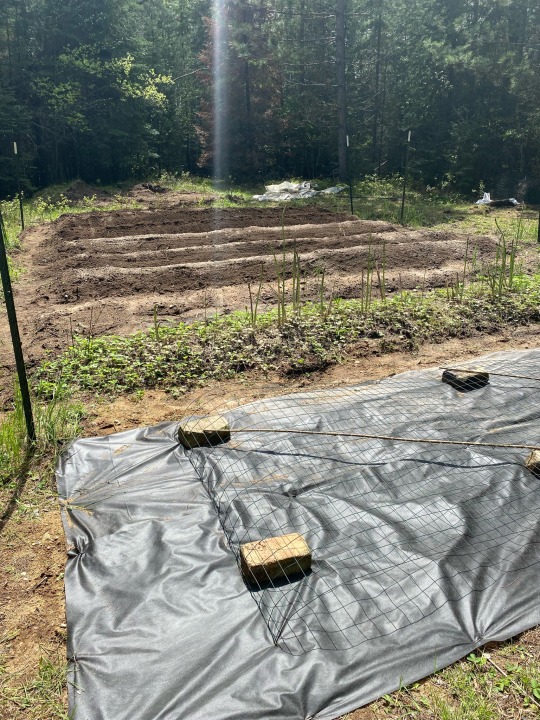
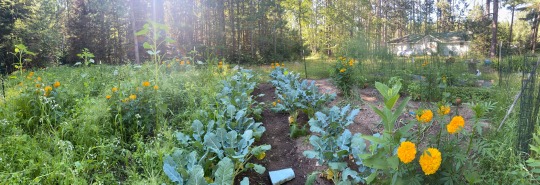
#autistic joy#gardening#my crops are watered#my fields are flourishing#who am I kidding it’s Minnesota I only just got rid of the last of my snowbank last week my garden is still just DIRT#but my daffodils are blooming and the maples are starting to leaf out 🥰#I might even dare plant my perennials next week!
10 notes
·
View notes
Text
What I was taught growing up: Wild edible plants and animals were just so naturally abundant that the indigenous people of my area, namely western Washington state, didn't have to develop agriculture and could just easily forage/hunt for all their needs.
The first pebble in what would become a landslide: Native peoples practiced intentional fire, which kept the trees from growing over the camas praire.
The next: PNW native peoples intentionally planted and cultivated forest gardens, and we can still see the increase in biodiversity where these gardens were today.
The next: We have an oak prairie savanna ecosystem that was intentionally maintained via intentional fire (which they were banned from doing for like, 100 years and we're just now starting to do again), and this ecosystem is disappearing as Douglas firs spread, invasive species take over, and land is turned into European-style agricultural systems.
The Land Slide: Actually, the native peoples had a complex agricultural and food processing system that allowed them to meet all their needs throughout the year, including storing food for the long, wet, dark winter. They collected a wide variety of plant foods (along with the salmon, deer, and other animals they hunted), from seaweeds to roots to berries, and they also managed these food systems via not only burning, but pruning, weeding, planting, digging/tilling, selectively harvesting root crops so that smaller ones were left behind to grow and the biggest were left to reseed, and careful harvesting at particular times for each species that both ensured their perennial (!) crops would continue thriving and that harvest occurred at the best time for the best quality food. American settlers were willfully ignorant of the complex agricultural system, because being thus allowed them to claim the land wasn't being used. Native peoples were actively managing the ecosystem to produce their food, in a sustainable manner that increased biodiversity, thus benefiting not only themselves but other species as well.
So that's cool. If you want to read more, I suggest "Ancient Pathways, Ancestral Knowledge: Ethnobotany and Ecological Wisdom of Indigenous Peoples of Northwestern North America" by Nancy J. Turner
57K notes
·
View notes
Text

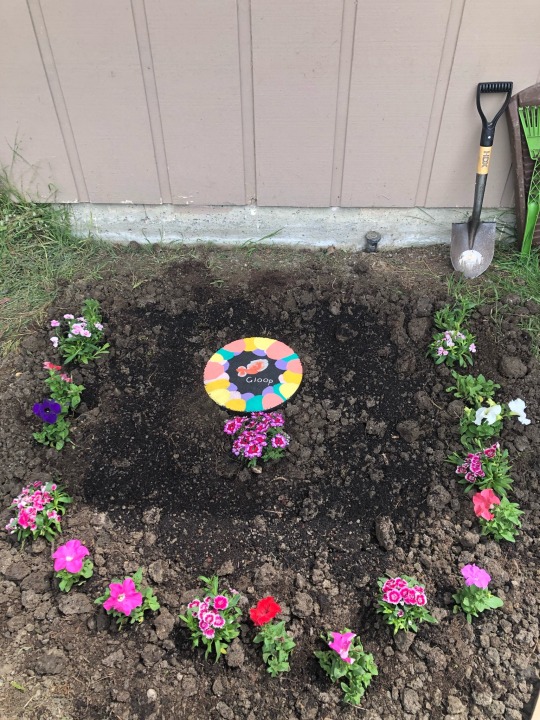
my sister requested a memorial flower garden for her fish’s grave so I spent all day creating this
#personal#we have clay soil so this is a work in progress. some soil amendments. annual flowers for the rest of summer#when they die the roots will decompose and create airways in the soil and break up the clay#next I plant a cover crop. thinking fava beans. which will choke out weeds add nitrogen and create better soil#then next spring we plant some perennial flowers!#oh also in all of the empty space we sowed seeds.#California poppies and some kind of larkspur I believe
1 note
·
View note
Note
Hello, I was wondering if you had anything writing notes related to winter such as vocabulary, phrases, etc.
Word List: Winter
Winter—the season between autumn and spring comprising in the northern hemisphere usually the months of December, January, and February or as reckoned astronomically extending from the December solstice to the March equinox; the colder half of the year; a period of inactivity or decay
Dead of winter - the middle of the winter
Midwinter - the winter solstice; the middle of winter
Nuclear winter - the chilling of climate that is hypothesized to be a consequence of nuclear war and to result from the prolonged blockage of sunlight by high-altitude dust clouds produced by nuclear explosions
Outwinter - to stay outdoors in winter
Winterberry - an eastern North American shrub (Ilex verticillata) of the holly family with axillary flowers, usually bright red berries, and deciduous leaves that turn black in the fall; called also black alder
Winterbloom - witch hazel; azalea
Winterbound - restrained (as from a favored sport or other outdoor activity) by winter
Winterbourne - a stream that flows only or chiefly in winter
Wintercreeper - an evergreen shrubby, trailing, or climbing euonymus (Euonymus fortunei) that is widely cultivated as an ornamental in several horticultural varieties differing chiefly in habit or in form or color of leaves
Winterer - one that winters; specifically: a winter resident or visitor
Winterfeed - livestock feed for winter use
Wintergreen - any of a genus (Pyrola of the family Ericaceae, the heath family) of evergreen perennial herbs (such as the shinleafs) that have basal leaves and racemose flowers; any of a genus (Gaultheria) of evergreen plants of the heath family
Winter-hardy - hardy in respect to winter conditions; especially: able to withstand much cold
Winterim - an intersession at some colleges and universities chiefly in January
Winterish - suitable to winter; suggestive of winter; somewhat wintry
Winterize - to make ready for winter or winter use and especially resistant or proof against winter weather
Winter-kill - to kill (a plant or part of a plant) by exposure to winter conditions; to die as a result of exposure to winter conditions
Winterless - free from winter; not characterized by wintery conditions (as of weather)
Winterlong - excessively or tiresomely long
Winterpea - a peavine (Lathyrus hirsutus) with densely silky pods that is native to the Mediterranean region but introduced into the U.S. as a green manure or winter forage crop
Winter savory - a perennial European mint (Satureja montana) with leaves used for seasoning
Wintertide - wintertime
Winterward - in the direction of winter
Winterweed - weedy plant that remains green during winter
Wintry - of, relating to, or characteristic of winter
The concept of winter in European languages is associated with the season of dormancy, particularly in relation to crops; some plants die, leaving their seeds, and others merely cease growth until spring. Many animals also become dormant, especially those that hibernate; numerous insects die.
Sources: 1 2 ⚜ More: Word Lists
Hope this helps with your writing!
#winter#writing reference#writeblr#dark academia#word list#literature#writers on tumblr#spilled ink#writing prompt#poets on tumblr#creative writing#poetry#fiction#words#linguistics#langblr#lit#light academia#writing resources
144 notes
·
View notes
Text

A sample of common crops of Uanlikri, with a focus on crops grown on the Ojame archipelago.
More information under the cut.
Grains
Several types of grains and grain-like crops are cultivated in Uanlikri. Of these, the four major types are millet, sand rice, swamp rice, and amaranth (not depicted).
Millet and sand rice are heat-loving and drought tolerant, with sand rice requiring especially good soil drainage but being more cold hardy. They are the main staples north of the Kantishian Mountains. Millet is favoured in the wetter Basin region, and sand rice in the dryer, more mountainous western regions, and both are grown equally in the continent's hot and arid northern desert.
Swamp rice is another important staple of the Basin region: though cultivation is complexified by its extremely heavy water requirements (swamp rice only grows in marshes or riverbanks), the complex river deltas leading to the Basin's inner seas are ideal for its cultivation and have been heavily modified to create artificial wetlands where swamp rice can be grown. Some strains of swamp rice have good cold hardiness allowing them to be grown south of the Kantishian Mountains. Swamp rice has also been selected for salt resistance: it is an especially important crop in the cold brackish marshes of the Cianji river and in the hot saltwater marshes of the Ojame Archipelago.
Amaranth is primarily cultivated in southern regions of Uanlikri. In the southern Basin region, they are a supplemental crop, but up in the mountains and in the cold lands south of the Kantishian, amaranth is the main staple. Mountain amaranth is especially frost resistant and able to survive nightly summer frosts in the Kantishian's high plateaus.
Red oats, known in the Ojame archipelago as uciwici, is a locally important crop grown in eastern coastal regions. Red oats is sensitive to extreme temperatures and does poorly in continental climates, but its extremely high salt resistance and ability to grow in poor soils make it a crucial crop by allowing cultivation to extend to otherwise marginal areas such as sandbars, coastal dunes, and other poor, rocky and sandy soils. It is appreciated for its purple grains with a naturally slightly salty taste, and for its decorative red foliage which retains some of its colour when dried, making it useful for basketry.

Ferns
Other grain-like crops grown in Uanlikri are seed ferns. Seed ferns are distantly related to true ferns and cycads. Two species are cultivated in Uanlikri: a climbing seed fern grown South of the Kantishian and which produces large numbers of small orange seeds attached to the underside of its fronds, and a caytoniale tree fern which produces modified fronds with large, round yellow seeds instead of leaves and is grown in the Upper Basin and Great Lakes region.
Climbing seed ferns are extremely prolific with a seasonal harvest on par with grain fields and well-keeping seeds with high nutritional value. The seeds are bitter with a taste somewhat reminiscent of burnt almonds and citrus peel, and are usually parboiled before cooking to remove some of the bitterness.
Caytoniale seed ferns are less prolific but are perennials. The seed envelope is also quite bitter, but the seed flesh has a pleasant neutral flavour and a crunchy, sticky texture not unlike that of meringue. Seeds keep well on the tree, but go bad quickly once harvested unless they are properly processed: seeds meant to be kept are parboiled, smoked, and ground into flour, while seeds meant for short-term consumption are either hulled and ground into flour, or hulled and grilled, often to be eaten as snacks alongside grilled insects.
True ferns are commonly consumed as greens, especially young fern shoots (fiddle-heads) and equisetum (horsetail) ferns. Antioles are less sensitive to the toxins in ferns, and parboiling of fiddleheads is often done but not strictly necessary unless consumed in great quantities.
Legumes
Legumes grown for food are historically rather rare in Uanlikri prior to the conquest of the Western Peninsula by the Senq Ha Empire. There are only two important legume crops in Uanlikri which are native to the continent: the grosbean, and the wax pea.
Grosbean is a vine which produces short, rectangular pods containing two to three large beans. The beans are exceptionally large, very colourful, and have a somewhat chalky texture. They used to be a staple in the Basin region, but have been mostly displaced by more palatable varieties introduced by Senq Ha colonists, though they are still grown for jewellery.
The wax pea is short, somewhat vine-like plant producing smooth pods containing a single unpalatable, extremely waxy pea. Though they are edible under duress, wax peas have never been grown as a food crop. They are instead highly valued for the wax which can be obtained by boiling the peas in a slightly acidic solution.
Other legumes (not depicted) have grown in popularity in the two centuries since and are now commonly eaten in most regions.
Roots and fruits
There is a great regional variation in the crops grown for their greens, roots, and fruits. This section should be treated as a sample of a sample, focused more closely on crops grown in the Ojame Archipelago.
Fruits
There are several species of ginkgo in Uanlikri, all of which produce elegant foliage and edible nuts. The nuts stink and their skin can cause rashes, so they are to be manipulated with caution, but their creamy flesh is much appreciated for its strong cheese-like flavour, which confers a pungent taste to salty and sweet dishes alike.
Bird cherries are small, cherry-like fruits that grow on trees and bushes. Most bird cherries are tart and astringent and are used for a touch of tartness or in jams and other preserves. Some cultivars produce very sweet cherries. The seeds of most birdcherries are mildly toxic to antioles.
The arils of a few yew species are eaten by antioles, especially as a gooey prepared delicacy or in jams. All other parts of the yew plant are extremely toxic to antioles, and the arils must be consumed with extreme caution. Because of this, it is illegal to plant yews on the Ojame Archipelago and especially in Ranai, but due to the extreme longevity of these trees, there are several ancient yews in the city of Ranai which are important landmarks and sources of yew arils.
Various citrus are grown and used throughout the Northern parts of the continent: most are acidic and bitter, though there are also sweet varieties. In the citruses of Uanlikri, green is associated with sweetness, yellow with bitterness, and orange with acidity.
Sumac is an important culinary crop in the Ojame Archipelago: sumac fruits are processed for the production of malic acid, a popular flavoring and crucial ingredient in the traditional Ojame ceviches.
Mothberries are named after their pale blue flowers in the shape of a butterfly. It is a drought resistant plant originating from the northern regions of the continent and cultivated for multiple uses: its tuber and leaves are aromatic and medicinal and its fruit is very sweet.
Roots
Root vegetables of all kinds make up an important portion of non-staple crops throughout Uanlikri.
Fur yams are floury and sweet, with edible and prolific leaves with a distinctly "green" taste.
Gourd roots, named after their shape, are crunchy, aromatic and sweet, with leaves used as culinary herbs.
Reeds are an all-around essential plants, with young shoots eaten as greens, roots eaten as a staple by coastal and marshland peoples, and its dried leaves and stems essential materials in basketry.
Orange onions are one of the many varieties of alliums cultivated in Uanlikri. They are the most popular alliums in Ranai. They are potently sulfuric and milden considerably with cooking.
Sweet and pearl radishes (are not radishes) are different cultivars of the Uanlikri radish (not a radish) with crunchy, fresh-tasting and slightly bitter leaves and small starchy tubers which produce very fine starches.
Spindleaf yams are plants with strangely shaped, aromatic and medicinal leaves somewhat reminiscient of sage and a juicy, crunchy tuber with a slight, mustard-like bite.
These are just a sample of grains, ferns, legumes, greens, roots and fruits eaten in Ranai and elsewhere on the continent of Uanlikri. Many of these plants have a large number of regional cultivars, and each region has a variety of local plants they grow or gather which are not broadly eaten elsewhere.
#worldbuilding#art by me#uanlikri#antiole world#speculative biology#speculative botany#also this took forever to do. not kidding#very fun though#unfortunately this does not really count for 'tober bc it's been done for a couple days. alas
103 notes
·
View notes
Text
By combining food-bearing trees and shrubs with poultry production, Haslett-Marroquin and his peers are practicing what is known as agroforestry — an ancient practice that intertwines annual and perennial agriculture. Other forms include alley cropping, in which annual crops including grains, legumes, and vegetables grow between rows of food-bearing trees, and silvopasture, which features cattle munching grass between the rows. Agroforestry was largely abandoned in the United States after the nation’s westward expansion in the 19th century. In the 2022 Agricultural Census, just 1.7 percent of U.S. farmers reported integrating trees into crop and livestock operations. But it’s widely practiced across the globe, particularly in Southeast Asia and Central and South America. According to the U.N. Food and Agriculture Organization, 43 percent of all agricultural land globally includes agroforestry features. Bringing trees to the region now known as the Corn Belt, known for its industrial-scale agriculture and largely devoid of perennial crops, might seem like the height of folly. On closer inspection, however, agroforestry systems like Haslett-Marroquin’s might be a crucial strategy for both preserving and revitalizing one of the globe’s most important farming regions. And while the corn-soybean duopoly that holds sway in the U.S. heartland produces mainly feed for livestock and ethanol, agroforestry can deliver a broader variety of nutrient-dense foods, like nuts and fruit, even as it diversifies farmer income away from the volatile global livestock-feed market.
[...]
Trees actually have a much longer and more robust history in the Midwestern landscape than do annual crops. Think of the Midwestern countryside before U.S. settlers arrived, and you might picture lush grasses and flowers swaying in the wind. That vision is largely accurate, but it’s incomplete. Amid the tall-grass prairies and wetlands, oak trees once dotted landscapes from the shores of Lake Michigan through swathes of present-day Indiana, Illinois, Iowa, and Missouri, clear down to the Mexican border. These trees didn’t clump together in dense forests with closed canopies but rather in what ecologists call savannas — patches of grassland interspersed with oaks. Within these oak savannas, which were interlaced with prairies, tree crowns covered between 10 percent and 30 percent of the ground. They were essentially a transition between the tight deciduous forests of the East and the fully open grasslands further west. And in the region where Haslett-Marroquin farms — part of the so-called Driftless Area, which was never glaciated — trees proliferated even more intensely. In pre-settlement times, according to a 2014 analysis coauthored by Iowa State University ecologist Lisa Schulte Moore, closed-canopy forests of oaks, sugar maples, and other species covered 15.3 percent of the area, and woodlands (low-density forests) took up another 8.6 percent. Prairies — the ecosystem we readily imagine — composed just 6.9 percent. Oak savannas made up the rest.
10 September 2024
95 notes
·
View notes
Text

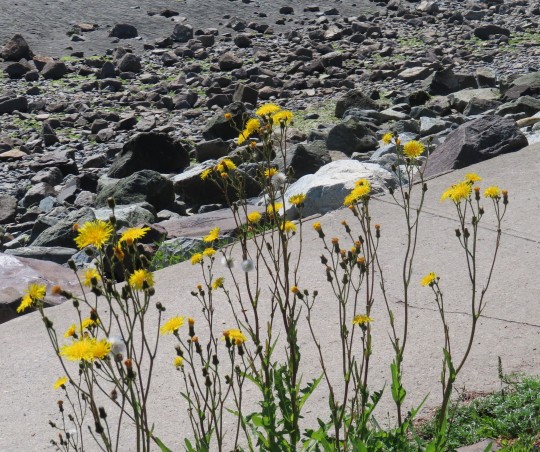
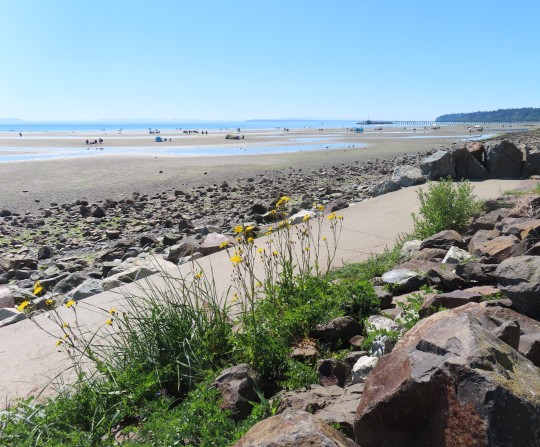
Sonchus arvensis (perennial sow-thistle)
Round-up
A perennial sow-thistle enjoys a sunny day at the beach. This plant is native to Eurasia but is often described (by farmers) as a noxious, invasive weed, and is now 'naturalized' throughout North America, South America, Russia, New Zealand and Australia. Like it's relative the dandelion, it arrived from Europe during the Age of Exploration and it's probably been growing in North America for five hundred years. I have no doubt that the first seeds arrived on someone's muddy boot.
The Minnesota Wildflowers website reports, "This species is a rapid colonizer from deep, extensive underground root systems. Once listed as a Minnesota state noxious weed, it is now widely established throughout the state but is not as problematic agronomically as was once thought. Round-up Ready crops took care of much of the problem." '
Round-up (2,4-d) is a powerful broad-spectrum herbicide used extensively in modern agriculture. Round-up Ready crops include soy, corn, canola, alfalfa, sugar beets and cotton and Round-up resistant wheat is under development. Round-up has been extensively tested and under normal concentrations it is not considered injurious to human health but this research is controversial and many lawsuits are pending. In 2023, 91% of the corn, 95% of soybeans, and 94% of cotton produced in the United States were from genetically modified, herbicide-resistant strains. For everybody's sake, I hope these safety studies are correct.
A final note: as a gardener you are advised to wear long pants, a long sleeved shirt, gloves, goggles and a mask when applying Round-up, not that anybody does. Personally, I never use the stuff. I get rid of weeds the old-fashioned way - I use my hands.
#flowers#photographers on tumblr#sow thistle#Round-up#invasive plants#fleurs#flores#fiori#blumen#bloemen#White Rock beach#Vancouver
63 notes
·
View notes
Text
food & agriculture in fallout: extrapolation and speculative worldbuilding
Okay, well. This is going to be an extremely long and data heavy post. Bear with me.
I'm going to go into detail about the crops and available food given to us canonically and textually. I'm going to be drawing some real world parallels between the crops we see in Fallout and what we have here. I'll be pulling relevant data from all the games, but the majority focus on this post is going to be about the east coast and Massachusetts in particular because it gives us the opportunity to participate in the agricultural climate of the wasteland.
Is there a point to this? Not really, but I'm pedantic and I take things too seriously.
my sources will be linked in the text throughout. for those of you who want to read about agricultural and growing zones of the continental united states, please follow me under the cut.
Growing zones and real world agriculture
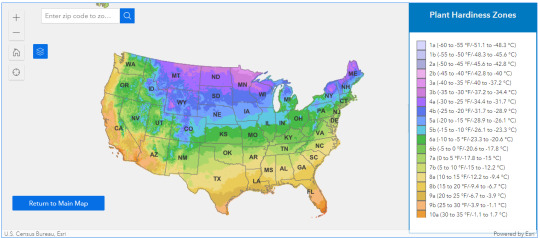
Shown here are the growing zones of the united states, divided into a temperature map of about 19 different regions. It's fairly intuitive to read -- colder temperatures are north and east, while warmer temperatures are south and west. The majority of the Mojave desert sits between 7a to 9a, a temperature range of about 20 degrees. DC and the nearby section of the southeast coast sits between 7a and 8a. The interactive map linked below will tell you where your growing zone sits.
The 2012 USDA Plant Hardiness Zone Map is the standard by which gardeners and growers can determine which plants are most likely to thrive at a location. The map is based on the average annual minimum winter temperature, divided into 10-degree F zones and further divided into 5-degree F half-zones.
For the moment, we are going to focus on Massachusetts.

Using the temperature above, we can see that the growing zone of Massachusetts is 5a (-20f) at it's very coldest, all the way to 7b, (5f) at it's warmest during winter. Most of what we see in fallout 5 sits in the 6a to 6b zone, which is middle ground during the winter, but cold enough to want to warrant crops that can withstand the frost.
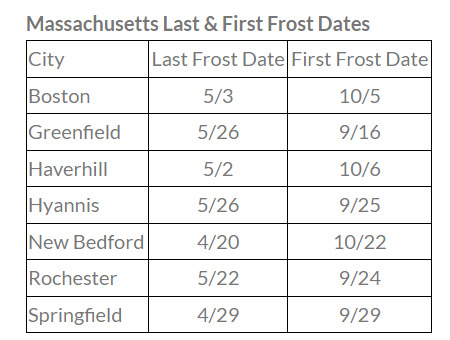
There is a solid 5 month window for planting annual crops, like corn, melons, and gourds like pumpkin. Your perennial crops are limited to fruit trees and possibly grains, depending on the variety and whether or not a perennial variety has been bred.
Cold weather crops include beets, carrots, greens like cabbage, collards, kale, and potatoes. These aren't the types of crops that will survive the winter as much as these are foods that can go in the ground as soon as it is unfrozen enough to be workable. Root vegetables and greens can germinate in soil as cold as 40 degrees Fahrenheit, which provides some leeway with unpredictable frosts and late planting times.
Much of the agricultural landscape of Massachusetts is dependent on the dairy industry, farming cattle, and aquaculture -- fishing and catching shellfish. Those with access to the coasts, fish and shellfish ought to provide protein during lean months.
Why are we talking about this? Well, if we're stepping into the shoes of a subsistence farmer in the fallout universe, we're going to have to take into account climate and ideal planting times for certain crops. It's not wholly important in terms of things like fic writing, unless you happen to be writing about the life and times of wasteland agriculture, in which case, I hope this is helpful! Again, I am pedantic, and this section is to provide a template when considering and discussing other parts of the game and what their specific diet and agricultural landscapes might look like.
Something to keep in mind when thinking about how farms might function in the Mojave, for instance, or if you're doing worldbuilding for a different part of the US.
Crops in the fallout universe
Now that we're familiar with growing zones and why certain crops are planted and when, we're going to apply some speculative worldbuilding to fallout itself. We will be revisiting growing zones when we talk about other climates, but for the moment, we're going to focus on fallout 4.
Now to preface -- I don't think that the food that is given to us in game is wholly representative of the plants or animals that survived the apocalypse. If some managed to mutant and survive, I'm willing to bet others did. I certainly won't deduct any points from anyone who wants to talk about growing cotton, or farming peaches or cherries, and I won't raise any eyebrows if someone includes things like spices into their wasteland cuisine.
In the 210+ years since the bombs fell, I do not think that the majority of the US is a desolate wasteland, but this post is not going to be my beef with the devs about how brown everything is. This beef is about food in particular. However, for sake of ease, I'm mostly just going to focus on the food that is presented to us in game.
There will be some extrapolation and speculation later, but if I do that for everything, then we'll be here all day, and we've all got things to do.
I would also be remiss to mention that agriculture in the US is old. It predates colonialism. The Native Americans cultivated the land long before any European settlers. They practiced a type of crop growing referred to as Three Sisters planting, which utilized corn, pole beans, and squash -- all things that exist in the agricultural landscape of Fallout as we know it.
Corn
I'm not going to say much about corn because there's not a lot to say about it. We all know what corn is. Fallout's corn is visually similar to wild violet, a hybrid corn.

But I am not going to say Fallout's corn is one such variety or another. In the 210 years since the bombs dropped, I imagine corn varietals have been bred and interbred a thousand times, and it is probably it's own unique strain. It's kind of a moot point. Corn is corn. You can do with yellow corn what you can do with wild violet, and whatever special breeds that make up Fallout's corn.
Corn is the third largest plant-based food source in the world. Despite its importance as a major food in many parts of the world, corn is inferior to other cereals in nutritional value. Its protein is of poor quality, and it is deficient in niacin. Diets in which it predominates often result in pellagra (niacin-deficiency disease). Corn is high in dietary fibre and rich in antioxidants.
You can do a shit ton with corn. It's a staple grain. It would not be incongruous with the fallout setting to have settlers making tortillas, cornbread, polenta, grits, tamales, etc. Corn can also be used to make corn whiskey. The husks can be spun into yarn and woven into garments similar to cotton, which I thought was interesting and also solves the problem of where the hell wastelanders are getting their clothes. Corn can be used as livestock feed, especially in the winter when cattle can't graze. While corn is a staple grain of the US, the east coast has minor corn production compared to places like the midwest. Corn is a staple, but it does not consist of the entire diet of your average wastelander.
Carrots
Not going to say much about carrots either. They're carrots. They grow well in colder soil and tend to have a lot of natural sugars. The carrots we're shown in FO4 seem to be a mutated variety different than the "fresh carrot" consumable in FNV, but there's virtually no difference, so I'm not counting it. Make some carrot cake.
Razorgrain
"This species appears to be quite promising. It's a toothy grain that we may be able to grind in order to replace wheat, which is untenable in the Wasteland. We are uncertain how to increase crop yields, which are very unpredictable. Will continue to study."
Razorgrain is our first unique mutated crop in the fallout setting. It most closely resembles a barley or a rye. Both are a fairly hardy species and can grow all across the continental united states; rye can germinate in cold weather temperatures. It wouldn't be outrageous to assume that razorgrain is similar too or a crossbred variation of both rye and barley. I have decided to base the majority of my research assuming it is a barley variant. Barley is also a major crop on the east coast near the Commonwealth, so that would explain why razorgrain is present in FO4 and not in the other games.
Barley requires a mild winter climate and can grow in growing zones 3-8, so it would be viable in Massachusetts. Barley can be milled into flour and it contains gluten; the gluten content of North American wheat and barley tends to be higher to survive the colder climates, so razorgrain would likely be very glutenous. It is also less susceptible to ergot than rye, but barley can still become infected -- and, I am assuming, razorgrain could as well.
Razorgrain fills the nutritional niche of carbohydrates and can be used to make breads, cakes, pastas, etc. It produces darker breads that have an earthier flavor than milled white flour. There has to be some method of actually milling the grain, though, which is an intensive process that can often be dangerous. Grain can also be used to make malted candy, which is our first option for wastelanders with a sweet tooth. Obviously, razorgrain can also be used to make malt or grain alcohol and is probably the source of all the beer you find littered around the wasteland.
Gourds and melons
Gourds and melons are actually a part of the same family, Cucurbita. The category of 'gourd' covers several different kinds of vegetables, including ornamental fruits that shouldn't be eaten. We aren't going to spend a whole lot of time on this one, simply because canon doesn't tell us that much and there's a lot of wiggle room in terms of interpretation.

FO4's model looks the most similar to a pumpkin, but it could be some other squash varietal from the Cucurbita family, which includes watermelon, honey melon, cucumber, squash, zucchini and pumpkin.
Melons is another pretty broad category. Melons and squash are part of the same family, as mentioned above. If we're going visuals again, the model is likely intended to resemble a watermelon. Watermelons grow best in humid and semi-arid environments between 70 and 8- degrees Fahrenheit. It's not impossible for wastelanders to be growing watermelons, but considering the humidity and frequent rainfall in Massachusetts, the melons would be vulnerable to fungal infections.
There isn't a lot of information on what specifically gourds and melons are in the fallout universe, so you could get away with writing in a pretty wide variety. Personally, I lean a little bit towards melons being a muskmelon variety, like cantaloupe or honeydew. Squash fills in some vitamin requirements for the human diet, and can be canned and stored for winter. It tends to be high in vitamin C and magnesium.
The limit to this one seems to be your imagination. Go crazy.
Mutfruit
This wiki claims that the mutfruit (it has a scientific name apparently, malus maata) is a mutated species of apple and crabapple. There are two different wikis about the mutfruit, both distinct. The first is linked above. The second is linked here -- I got most of my information from this second wiki.
There is a handful of "canon" information we can take from this set of wikis.
Priscilla Penske in Vault 81 is attempting to create foods that have increased resistance to radiation. She mentions the mutfruit would do well, but isn't certain how the hybridization would affect the flavor and texture.[5]
This claim is taken directly from the second wiki, but in comparison, it makes no sense. If the mutfruit tree is a product of mutation, then radiation shouldn't really affect it at all. It's survived and propagated to this point, hasn't it? I am disregarding this claim on the basis of being stupid.
Farmers in at Warwick homestead will comment on the fruit's characteristics, such as tasting sweet and being versatile in recipes.[1][2] The vault dwellers of Vault 81 trade for mutfruit with the outside world, and use it to make special occasion desserts such as pie.[6][7]
If the mutfruit is an apple variant, then it likely has a high sugar content, and it would have to be harvested in the peak of summer or in early fall.
There are fresh apples the be found across the wasteland, implying the existence of apple trees that have been unaffected by the bombs. Personally, I was assuming that the mutfruit was some kind of blackberry, given its appearance as a clustered fruit, or maybe even a type of plum. Regardless, the mutfruit is a fruit, which means that it would preserve well by being jarred or canned, has a high sugar content, and could likely be reduced to form sugar syrups. Like any fruit, it could be used to make alcohol.
Tatos
I want to stop myself from editorializing too much, but goddamn tatos. The crop that makes the least goddamn sense in the fallout universe. The bane of my existence. Let's get into it.
First off, we're given some pretty damning canon facts about tatos:
Tatos are a mutated hybrid of the cross-pollination of the tomato and potato plants.[1] The new consumable looks like a tomato on the outside, but the inside is brown.[2] Commonly cultivated in the Commonwealth, Appalachia and on the Island, its fruit is easy to grow and can keep one from starving, but their taste is described as "disgusting"[2][3][Non-game 1] and resembling "ketchup-flavored cardboard."[1]
According to some old botany texts we found, this appears to be combination of a now extinct plant called a "potato" and another extinct plant called a "tomato." The outside looks like a tomato, but the inside is brown. Tastes as absolutely disgusting as it looks, but will keep you from starving.
Note: This text was written from the perspective of someone who is unaware that both the tomato and the potato are being cultivated elsewhere. The writer also does not mention any sort of DNA test. However, the potato is also found in the Capital Wasteland, and the writer is a scribe in the Brotherhood of Steel, which originated from that area.
Both potatoes and tomatoes are from the nightshade family. They have the same nutrient requirements, and would compete for resources if planted separately but in the same soil. There is a method for planting them together where you splice a tomato stalk onto a potato root, but this is not the same as cross pollination and will not result in what fallout presents as a tato. What will happen is that the roots will grow potatoes and the fruit of the tomato will branch off the stems.
The potato itself is a stem tuber -- high in starch and calorically dense. A stem tuber is an offshoot of the parent plant that will grow beneath the soil as a type of asexual budding reproduction. We all know what a potato is. The tomato is a berry. It's the ovary of a flowering plant -- again, we all know what a tomato is.
I am going to give Fallout a little bit of grace and not comment on how mind bendingly stupid their description of a tato is. The outer skin is a tomato, but the inside is brown and starchy like the potato? I am not going to comment on how it makes little to no biological sense. The starchy tuber is starchy because it's an energy and nutrient storage device. The tomato is the enlarged ovary of a fruit. Why did those things, which are separately very good, combine into one very terrible thing? I don't know. It doesn't make sense. I don't really want to think about it. But these are the facts as they are given to us in game and I suppose I have to live with that. Obligatory "goddamn you todd howard. a pox on your house."
The tato is probably extremely calorically dense. It's specifically mentioned as being easy to grow and it is a better alternative to starving. It's probably grown as a staple crop throughout the planting season. I'm not entirely sure if the tato can produce glycoalkaloids like the potato does (that is, the green sections of the potato that can become poisonous when exposed to light) but if they can, and if stored improperly, it would negatively impact the health of whoever ate them.
I suppose since the taste is so offensive, tatos are better served as a carrier of some other type of food. Fried, mashed, baked -- the purpose of the tato is simply to get calories into your body. Starch can also be turned into alcohol, which I am going to need a lot of after reading the canonical facts of this stupid fucking plant.
Fallout: The Roleplaying Game Rulebook p.158: "A mutated hybrid of the pre-War tomato and potato plants, with the stem and reddish skin of the former and the brownish flesh of the latter. Tatos provide decent nutrition, but taste disgusting. However, they’re relatively easy to grow and thus are a staple of wasteland agriculture and is an ingredient in a variety of recipes."
fucker
"non farmable" crops
You can't cultivate these plants, but again - we're taking what's given to us and interpreting it extremely literally. There is no reason that these crops could not be domesticated and farmed.
Siltbean
Siltbean is likely a type of bushbean, rather than a pole bean. It's squat and low to the ground. Bush beans require little care or attention and you can pick them when you're ready to harvest them. Historically in North America, beans and corn were grown side by side (though those beans were pole beans using the stalks as support). Bush beans require successive plantings since harvests are early.
There's no good allegory for what type of bean this might be. The potato bean (Apios americana) is native to North America and also produces edible tubers, but there's no reason this couldn't be just some other type of bean. No beans that I could find had red/orange pods.

Beans are a good source of both proteins and carbohydrates, and another crop that can store well for the winter.
Tarberry
Tarberry is a little iffy, considering it is farmed by the ghouls at The Slog, but they're the only farm shown capable (or willing?) to farm the berries. Originally, I had assumed that tarberries were a type of mutated cranberry, and I thought the wiki was supporting me in that claim by saying this:
Tarberries are small, dusty orange berries of the tarberry plant. It is a water-grown crop similar to cranberries.
But cranberries themselves are also canon in the world of Fallout. So who knows! There's no canon information presented on the tarberry's characteristics, so it can be treated the same as any other fruit or berry.
Fungus variants
Glowing fungus: Glowing fungus is one of the few real world equivalents we have. It is a Japanese mushroom called Enoki. It is also farmable as shown in FNV at Hell's Motel.
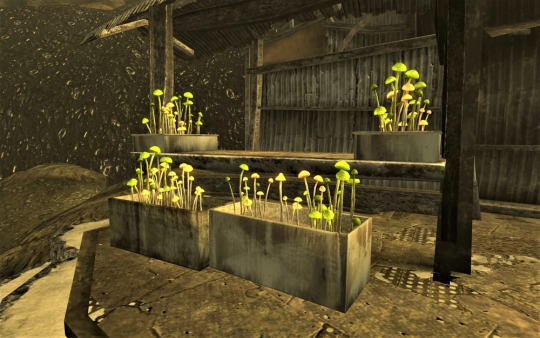
Brain fungus: This is harvestable, but there aren't any "crops" shown as we would consider them. Considering it's benefits as a mentat replacement, then it's likely that there could be a dedicated space for growing it.
Food and Plants mentioned in the text
Potato
Thank god almighty, potatoes are canon in the universe of Fallout. Fresh potatoes are found as consumables in FO3 and FNV but potatoes are also mentioned in the text of FO4:
Mentioned in dialogue -- {Angry} Shut up Jake. If I hear anything out of either of you, you'll both be peeling potatoes for the next year.
I'm taking this as word of god. Potatoes are canon and I don't care what anyone says.
Tomato
Tomatoes are mentioned in the text, but are never actually seen in game. The only hint that this plant survived extinction is this excerpt from the wiki.
Note: As fresh tomatoes and potatoes are seen in the Mojave Wasteland as of 2281, with the potato seen in the Capital Wasteland as of 2277, the claim of either's extinction by 2287 in the Commonwealth Plant Database could be taken to mean local extinction in east coast regions, as opposed to global extinction. This entry may also just be in error.
There's potential for leeway here, but take it as you will!
Fresh apple
We discussed this back up in the mutfruit section of the essay, but the existence of fresh apples implies the existence of non mutated apple trees. They're found in both FO3 and FNV as a consumable item, so the apple tress have either proliferated across the continental united states, or multiple varieties survived the bombs.
Fresh pear
See above. Pears are also naturally high in pectin, which makes them useful for making jams and preserves.
Pinto beans
Pinto beans are a consumable in FNV and is another W in the bean category of the agricultural landscape.
Jalepeno
Look, I'm picking out this one specifically because I need to believe that other spices and peppers exist in the world. Where would we be without her? Nowhere good.
Raw sap
I am going to say that sap collecting is probably where most of the sugars and sweeteners in the wasteland come from. It's relatively easy to tap trees and collect sap, and it only takes a few hours to reduce the sap down into useable syrup.
Wild Blackberry, Lime, Cranberries, as well as Watermelon as being distinct from simply 'melon' are all mentioned in the text. The list of fruits mentioned or found in the games can be found here.
Animal husbandry
Fallout doesn't give us a lot of canonical information on the animal side of farming. The biggest real world agricultural export of Massachusetts is dairy and cattle farming. Chickens are canon in the worldbuilding of fallout as of Far Harbor, but canon feels both restrictive and extremely loose with regards to what animals can be cared for and how.
We aren't going to spend a whole lot of time on this one, only because the information is pretty limited.
Brahmin
There are plenty of brahmin found throughout the landscape of the wasteland. We most commonly see them as either livestock or beasts of burden. Things like milk, cheese, and other dairy products would be common if a farm has access to dairy cows. The investment to raise cows would be enormous for a subsistence farmer. Dairy cows would likely be kept for a number of years, where steers would be raised 12 to 24 months before being slaughtered; they'd likely be grass fed in the summer and corn or grain fed in the winter. Leather and beef would be products, of course, and things like soap and candles can be made from the beef tallow.
Chickens
Chickens are largely easy to keep and care for, producing eggs and necessary proteins. Chickens can provide niacin, filling in the nutritional gap that would be left by a heavy corn based diet. The investment for keeping chickens is lower than raising brahmin, but so is the payoff.
Bighorners
Bighorners are mutated bighorn sheep native to the American Southwest.[1] Humans have since domesticated them for their horns, meat, milk, and hides,[2][3]
Granted, bighorners are only seen in FNV, but I don't think there's any reason they couldn't have migrated east. In the text, it says they're kept for meat and milk, but there's no reason that they shouldn't provide a fleece as well. In the colder climate of Massachusetts, they would find value in wool, which can keep its warmth even when wet. They may be sparse across the commonwealth, but that would make wool and fleece all that much more valuable.
Fish
Yeah, I know. Technically we can't fish in Fallout (and depending on the game you play, you might not even know what a fish is). But aquaculture is huge in Boston, and with access to the coasts, it's completely fair to say that fish, shellfish, and hydroponics is a completely viable source of food in the wasteland. We see dead fish washed up on shore all the time, along with whatever the hell those shark things are. There should be fisheries and fishing towns all along the coasts.
New Vegas and Fallout 3
Consulting our growing zone chart, we can see that much of the southwest sits between 7b to 8b. The winters in the southwest are fairly mild, and while you can get seeds in the ground sooner, the majority of the battle is going to be finding a reliable water source.
The farming we see in New Vegas has one distinct notable inclusion: the NCR sharecropper farm.
The sharecroppers are growing a number of crops, including maize, tobacco, pinto beans, and honey mesquite. Corn can handle hot, arid weather, it's just not commercially grown out west. Barley can also handle hot, arid climates, and razorgrain would be suitable for the western front -- maybe we can assume it's made it's way that far west and is being cultivated alongside corn.
Most of the plants we see in FNV aren't the type we would see typically domesticated for agricultural use, but that doesn't mean people haven't adapted to their surroundings. It makes a lot of sense for locals to have domesticated local plants like prickly pear and banana yucca. There are a number of fresh produce items to be found as consumables, alongside local fruits the local fruits.
Heat-loving plants are best suited for summer production in desert climates. The plant families that fit into the heat-loving category are nightshade or Solanaceae (tomatoes, peppers, eggplant) and squash or Cucurbitaceae (cucumbers, melons, summer and winter squash). Corn and beans also perform best in hot climates.
Most plants CAN handle the heat and climate of the southwest, the issue is just finding a reliable source of water. Somewhere close to Lake Mead or the banks of the Virgin River would be prime real estate for farming, since irrigation could be accomplished without the use of pumps, like the sharecroppers use.
If we look back at the history of agriculture, it's developed along established waterways in almost every ancient civilization because that's what's easiest. There should be thriving communities surrounding the lakes and rivers in the southwest.
Comparatively, DC was formerly a swamp. It's hot and humid in the summer, though the winters are fairly mild. It wouldn't be a stretch to say that farming practices in the Commonwealth don't differ all that much from farming in the Capital Wasteland -- you could even posit that food from the Capital is of better quality ever since the successful activation of Project Purity. Fresh and unirradiated food was growing there before, so it's entirely likely that even more is growing now. YMMV!
Other consumables
We would be here all damn day if I did research onto every single consumable item available across all three games, so this mostly just because I'm covering my bases.
I am going to say that sap collecting is probably where most of the sugars and sweeteners in the wasteland come from. It's relatively easy to tap trees and collect sap, and it only takes a few hours to reduce the sap down into useable syrup.
Look, I'm picking out this one specifically because I need to believe that other spices and peppers exist in the world. Where would we be without her? Nowhere good.
Pre War food
Most shelf-stable foods are safe indefinitely. In fact, canned goods will last for years, as long as the can itself is in good condition (no rust, dents, or swelling). Packaged foods (cereal, pasta, cookies) will be safe past the ‘best by’ date, although they may eventually become stale or develop an off flavor.
The risk with improperly canned good, or damaged canned goods, is botulism. Botulism will straight up kill you. You don't even have to consume that much of it; just a little bit will leave you dead in days. As desperate as I might be for a meal, I'm not going to risk dying because that can of two hundred year old peaches looks really tasty.
If properly sealed and in a dry, ideal environment, I... guess things like cereal and instant food could be okay? But again, with access to fresh grain, sugars, and yes, even potatoes and pasta, why would you want to risk eating InstaMash that's been around since before your great grandmother.
Pre War drinks
Sigh. Okay.
Unless stored extremely, extremely well, most bottled drinks aren't going to last much longer than 9 months. A year, if you're lucky. Exposure to sunlight and improper storage will break down the contents -- the best bottles are brown, then green. Clear glass is the worst because it does nothing to protect the liquid inside.
All the Nuka Cola you find throughout the world is flat, nasty, and will probably make you sick. I don't think that really needs to be pointed out, but there we go. I suppose the soda could probably be reduced to form sugar syrups, but with access to sap syrup and grain malt, I'm not sure why you would be desperate enough to do that.
So what does food look like in Fallout?
If there's one thing I know about humans, it's that humans like to eat. Food is culture, as much as culture and community is built around food. Good food and access to it is paramount to human happiness. All this to say is that food in fallout is whatever you want it to look like.
I can extrapolate and theorize all day long based on what Fallout tells us definitively, but I'm not going to tell you what the culinary landscape in the wasteland looks like. The only point that I will stress is that humans are really, really good at making things appetizing.
The fandom is already so creative when it comes to developing their idea of what food means in the wasteland. It's what's directly inspired me to write up this stupid, long ass post about farming and agriculture.
Obviously this is not a comprehensive list of all the base ingredients you can find in Fallout. I picked the ones I did because of the potential for consistent farming. Wastelanders have had two centuries to develop agricultural practices based around subsistence farming. I am not a subsistence farmer, and I have no idea how wasteland cottagecore would work at the heart of it. Running a farm is extremely labor intensive, and so much of your investment has to be immediately recouped in the form of eating what you harvest.
What a farm is likely to look like will start in the early spring when the ground begins to thaw, and a farmer can plant his cold resistant crops, like green vegetables and razorgrain. Potatos, carrots, and tatos will also weather the spring chill. When it starts to warm up, the more delicate plants like corn, beans, and squash or melons will get planted and tended to.
If your family is lucky enough to have a greenhouse, you can keep crops growing all through the winter and have a surplus for trade and barter, or just to preserve and refill the pantries.
A lot of the investment will have to be immediately recouped. Eggs from the chickens can't be preserved, obviously, but there will be meat from hunted animals, milk from the brahmin, probably an early harvest from the beans and tatos, and whatever else is in the pantry from the previous harvest.
Some of it will be canned or preserved in the forms of jams or jellies (just remember what I said about botulism). Meat from animals that get hunted can be smoked or otherwise preserved. Grain can be milled into flour or eaten whole and unshelled. Even the corn silk can be woven into clothes for the summer.
There really is no limit to what can be done in the end. While a lot of this information was taken from what we're given in the text, there's no rule that says you have to follow it word for word. If you believe something exists out there, then write it! We're all just making shit up as we go along anyway. If you need permission, then here it is. You can do whatever you want. Make up recipes! Go insane. Follow whatever your little foodie heart desires.
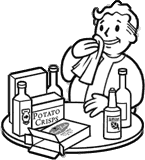
#fallout#kal talks#fallout 4#fallout new vegas#fnv#fallout 3#fallout meta#fallout food#fallout headcanons#behold. the agricultural masterpost of my farming headcanons#here she is
819 notes
·
View notes
Text
Spilled Inktober (Drawtober ) Vol. 2, 10.1.24 “Self Consuming Cycles”
Things come in cycles Physique isn’t unique As I laze and I graze Beneath the seasonal leaves Youth departs me, discarded as well Fall, after summer With full perennial bloom Freed from school halls and yards For brief respite I will admit I miss those sixty-sum days Knowledge used Leaves the rest abused, abandoned, neural nets Of thoughts, best off forgets Opportunities solicitations Are brief lovers First kiss visitations Come knocking Rocking my world with adumbrate pandorum Faith rekindled in scared Sorted and sifted Ignoring any doorstoop signage I was not ready then With little reason to believe A second coming, coming Of work, of love, of you Yet winds return The tides, the crops The spring to winter, temperature drops Skills that once elude, illume And onward so, life, resumes And propagate my garden-guarded mind The rising sun will always set Grief too, will forget A healing hand will break So others yet may mend The wheel spins on and on and on Do I approach or do I depart Around life goes As I die, I live yet still My stillness stirs Chance may come again, with effort made And so sad Sisyphus is not quite so alone Prometheus plucked and Helios’ racing sun Things must come in cycles Each day anew; our chance To gain what once was lost once more in past
@env0writes C.Buck Ko-Fi & Venmo: @Zenv0 Support Your Local Artists!
#twc#spilled ink#spilled inktober#drawtober#drawtober 2024#inktober#writing challenge#spilled inktober vol. 2#october#wutispotlight#writtenconsiderations#artists on tumblr#stream of consciousness#artists of tumblr#poetselixir#poem#poetry#greek mythos#slam poem#spoken word#env0 writes#twcpoetry#writeblrcafe#poetryportal#writerscreed#abstractcommunity#savage words#smittenbypoetry#poeticstories#poetscreed
32 notes
·
View notes
Text
I am not about to sit here and claim that any work is above reproach, but so many criticisms of RENT are either directly addressed within the show or are just. not true. and this perennial discourse about how Problematic it is annoys me, so here we go
Why don't they just pay the rent?
are you kidding me
did you watch the show??
they don't have any money
the situation established at the beginning is that Benny has allowed them to stay in their apartment rent free for the past year because Roger was unable to work and he and Mark wouldnt be able to afford living expenses as well as Roger's medication otherwise.
Benny then tells them that unless they break up Maureen's protest, they will not only have to immediately start paying rent, they will also have to pay back the entire previous year's rent or else be evicted
needless to say if you ware barely scraping by, you do not have a year's worth of rent and then some just sitting on hand
Mark was cosplaying poverty, he could've gone back to his parents' house at any time.
perhaps
all we know about Mark's parents from canon is that theyre pushy and he doesnt want to live with them. We don't know any details of their living situation or home life
but even if he would have been fine moving back home, it would have meant abandoning both the community he had grown into, and Roger.
Roger literally had not left the apartment since April died, and was not well enough to work to support himself at the time. Mark leaving would mean leaving Roger without support.
Mark's view of the homeless is often voyeuristic and expoitative.
yah
the conflict between Mark's comparatively privileged upbringing and the poverty amongst which he now lives is a major part of his character
remember when that homeless lady told him to fuck off
that didnt just slip in by accident
The whole show is about not being able to afford things, and then Mark quits his job for his Ideals.
Mark was not entirely jobless before being employed at the magazine. He wasn't going from having a job to unemployment. He always had money for food, clothes, medication, etc., even if it was tight
he just wasn't employed in his field. it wasnt a question of Having A Job or Not; it was about whether Mark was willing to accept the chance to get closer to making a living off of his art, even if it went against his morals, or whether he could be content carving out filmmaking for himself in a way that felt right
I thought Jonathan Larson was gay and died of AIDS.
not his fault??
neither Larson nor his estate ever claimed either of those things, you just jumped to a conclusion and made it everyone elses' problem
I can't believe this is a common "criticism"
A straight man has no right to write about the AIDS epidemic.
I dont know how to tell you this, but AIDS is not a gays-only disease. what are you, a politician from 1986?
RENT was not about being gay, it was about the disease. Roger, Mimi, Mark, and Benny- half the main cast- are all straight as far as the audience is aware. other than gay people, the most at-risk groups at the time were IV drug users, sex workers, people of colour, and impoverished people, all of whom are represented in the show
Larson may not have had AIDS, but many of his friends and loved ones did, and died of it. how incredibly callous to say that someone cannot write about the tragedy they personally lived through, just because they are not of the demographic you most associate with it
Larson plagiarized the whole cast and all the major story beats from Sarah Shulman's People in Trouble.
this is one that cropped up on tiktok a couple years ago
have you read the book?
I have
the only similarities are that they are both about poverty and AIDS in New York, and there are characters who cheat on their partners. that's it.
it's like saying Veep plagiarized The West Wing because theyre both about white house staffers. or like those guys who claim any fantasy story featuring swords and the hero's journey is a Star Wars ripoff. it' absurd.
RENT is directly and openly based off the opera La Bohème by Puccini, as well as incorporating autobiographical elements from Larson's life
stop just repeating things you hear
in conclusion: there are real criticisms and analyses to be had with RENT, but these are not them
41 notes
·
View notes
Text
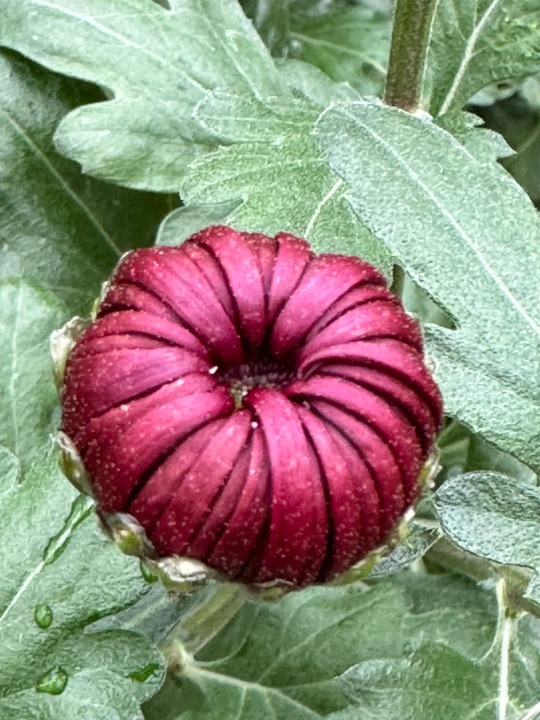

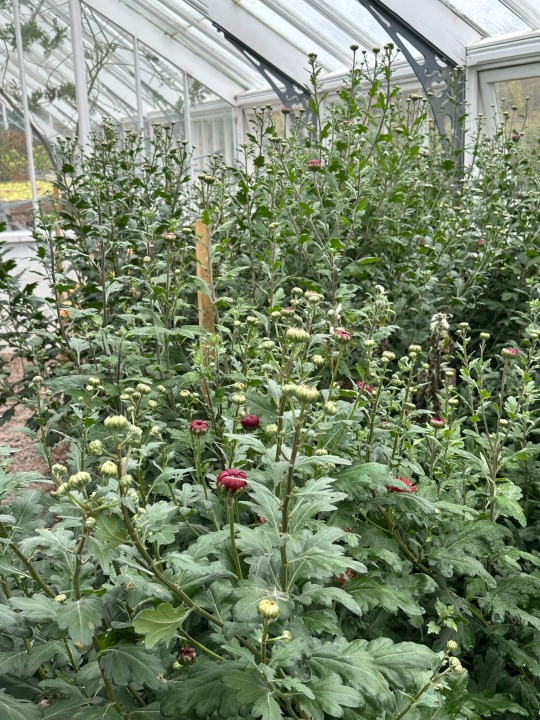
Plant of the Day
Sunday 24 December 2023
In the autumn and winter Chrysanthemum cultivars are a great glasshouse cut flower crop. These perennial plants, depending on the variety, can be hardy or half-hardy and thrive in a moist but well-drained soil with added compost or well-rotted manure. For larger single flowers the side-shoots are removed (known as disbudding) and plants will need staking.
Jill Raggett
#chrysanthemum#cut flowers#plants#horticulture#gardens#garden#herbaceousperennial#flowers#Gordon Castle#cool glasshouse#glasshouse#flower buds
112 notes
·
View notes
Text
market update // september 28th 2024


before market 👉 after market
another slow day. this time was because a lot of regular customers did come by to say hi, but that they were out of power after 2r hours from the hurricane so they were honest and said they just were there to get out of the house and not buying. when 3 different customers say that... then you know that's probably multiplied by at least 3. a lot of window shoppers overall at the market, not just me. about half the farmers didn't show up either because of storm damage. me myself and my hubs kitties and house are completely fine, but it was significantly worse south and west of us. and guess where most of the farmers are located 🫠
if there is ever any severe damage of any natural causes, they need your support then more than ever. they always need your support... but only the cash crop farmers are eligible for compensation loss from the USDA. the farmers at your local market are not eligible. support them.
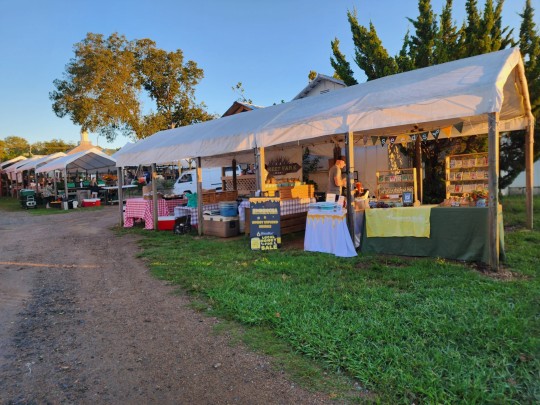
look at me, right at the very end. all my neighbors still setting up. the main market is right around the corner to the right. this is considered the back entrance so there is still traffic, but nowhere near as much as the main entrance.
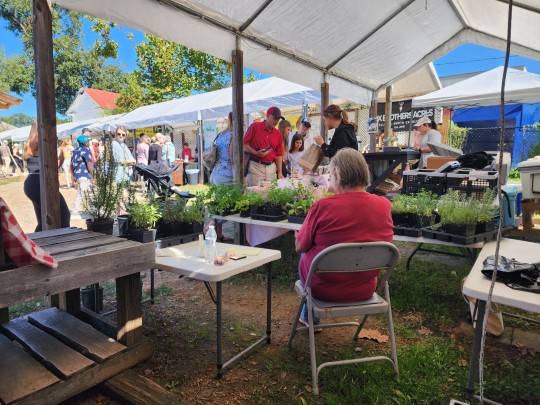
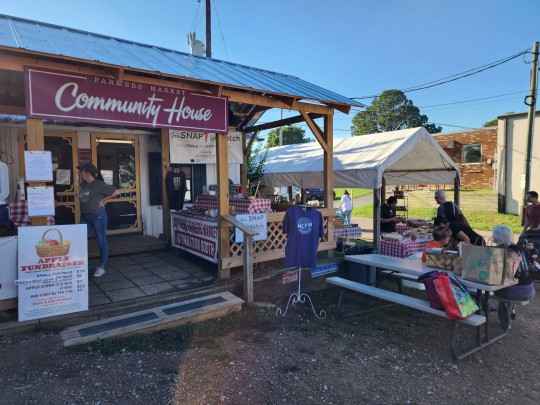
my sun tarp that kept attacking me when it was windy the other week didn't make it through the storm, so i spent about half the market taking refuge in the shade. i hung out with another plant vendor for a bit. i was telling her about my perennial flower garden, and i did already get spanish lavender from her. going to get more next time she's at market. she said spanish lavender is the easiest to grow - especially in these parts - but the flower heads don't look like the stereotypical lavender flower so a lot of people don't want it. i don't care, i want the bees to care! but she's wonderful, sells only herb transplants. she recommended a few more flower perennials for me... i forgot ehat they were but she said she got them so that's why i didn't bother remembering because i said SOLD and i'll get them from her later 😅 i'll tell y'all what they are when i get them.
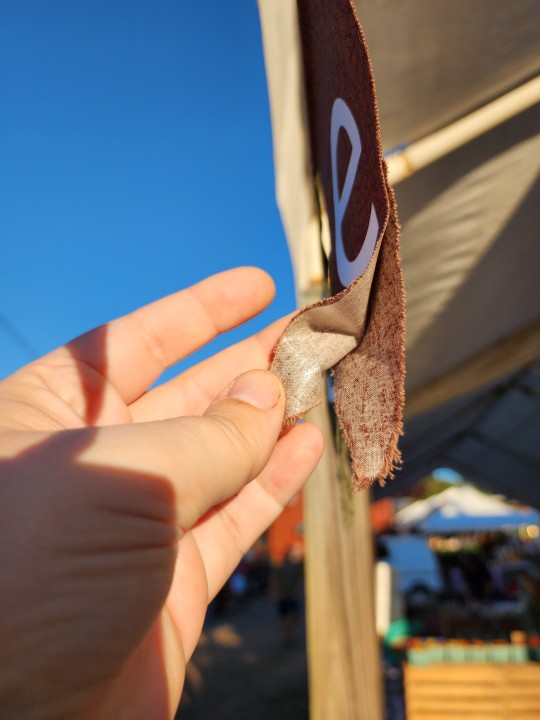
my sun tarp didn't make it, but my seed banner only got slightly frayed! easily fixable, fix it later.
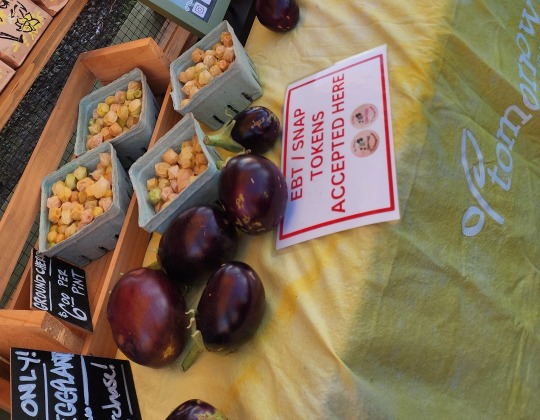

question of the day!! this applies to everyone, but this farmers market offers a special deal. if you have SNAPs, or food stamps...
seeds are covered by SNAPs!!
now, home depot or other large hardware stores won't accept SNAP cards because they don't sell food as their main source of income (well, customers aren't their main source of income but that's another post for another day). Those stores won't invest in accepting SNAPs to a "small" customer base. BUT!! Walmart, Target... other stores where they have groceries and a few seeds in the spring will accept SNAPs for vegetable and herb seeds. if it turns into something edible, it is covered by SNAPs:
✨️ the more you know ✨️ a couple of customers were surprised and got a lot of seeds after they learned that. me, personally, my goal is to eventually accept SNAPs on my website for selling seeds. it costs a lot of money to do so....... but it is still a high priority. for now, I can accept farmers' market tokens for the seeds.

close up of seeds. seeds. seed seed seed seeds. appreciate the seeds.
kid wave back count: 1 out of 1. not too many kids today, surprisingly, but the one i waved at waved back. 100% wave back rate, let's gooooo.
#food not lawns#gardening#home garden#homegrown#food#gardenblr#grow food#suburban agriculture#suburban farm#farmer's market#farmers market#home farm#suburbia farming#farming#suburbian agriculture#farmcore
21 notes
·
View notes
Text
Four blouses
A year ago I bought a metre of some very lovely and expensive Liberty Tana lawn. It sat in my small sewing stash until I could find a pattern for it. Eventually I settled on the Perennial Blouse. I was drawn to the simplicity of the shape, which lets the pattern shine will still being fitted and not the giant sack with elastic waist which seems so common in Indie patterns and which I have many many bitchy thoughts about.
I made a quick toile and found that as usual I needed to take length out of the body. It's designed to sit at the natural waist and I have a rather short torso. That's why it looks like a crop top but I swear it's not, that's just how short my upper half is! For reference I am 5'6" (167cm) and yet need a 32in (81cm) inseam, I really am mostly leg.
I made the cap sleeve version, and it was a quick and fairly painless project that is really elevated by the beautiful finishing on the inside and the thoughtful pattern elements, such as a button hole guide and separate pattern pieces for any interfacing, a well as properly drafted armscyes (the amount of armscyes that are symmetrical makes me weep).

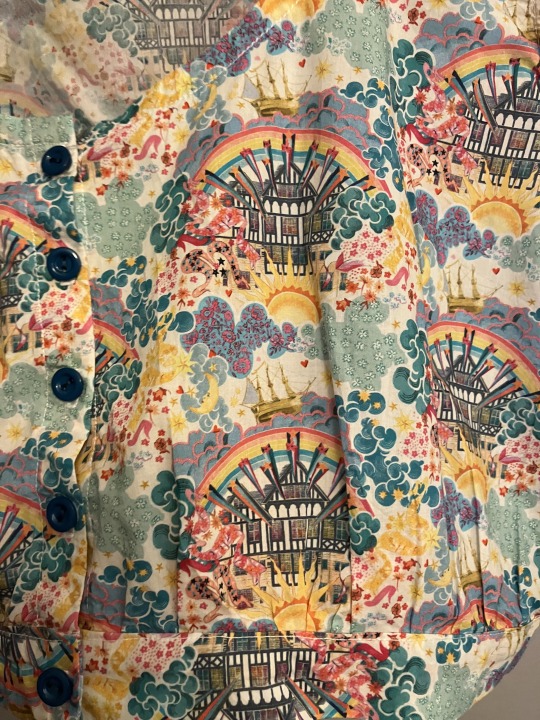
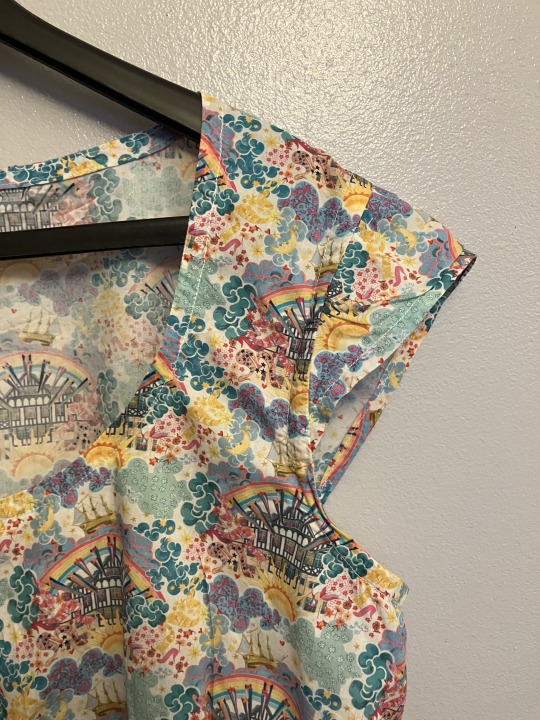
Here's some close ups of the pattern and the cap sleeves. I was very happy with the pattern. It's very economical for fabric, taking under a metre, and it really lets the print shine. In fact I was so happy I uh, went a bit wild
I had to give away almost all my handsewn shirts this year as my upper chest and shoulders no longer fit comfortable in them (swimming regularly will do that, and my high bust measurement has always been out of whack for standard pattern sizing anyway). So I wanted restock my handsewn blouses, and I knew I liked this pattern. So I made more.
This is a white cotton broiderie anglais, For this one I raised the scoop neck about 1.5 cm, and lengthened the body by a cm. I love the contrast of the orange buttons. I made the bias tape from some plain white polycotton because the embroidery on the body fabric would mean it was harder to use.
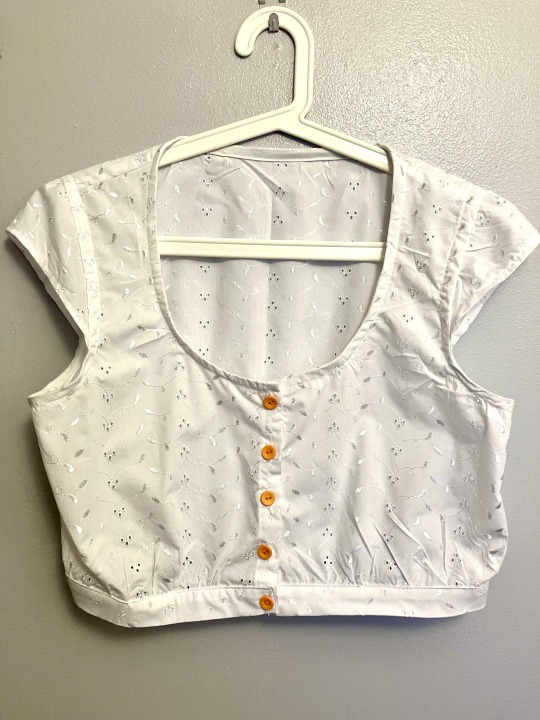
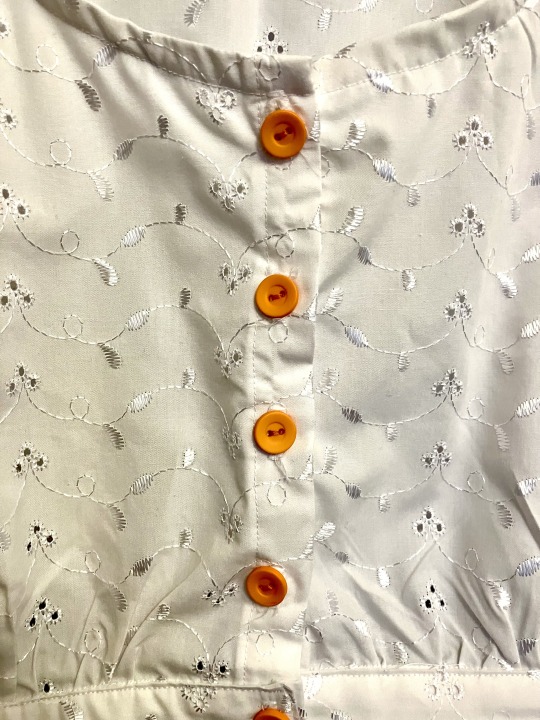

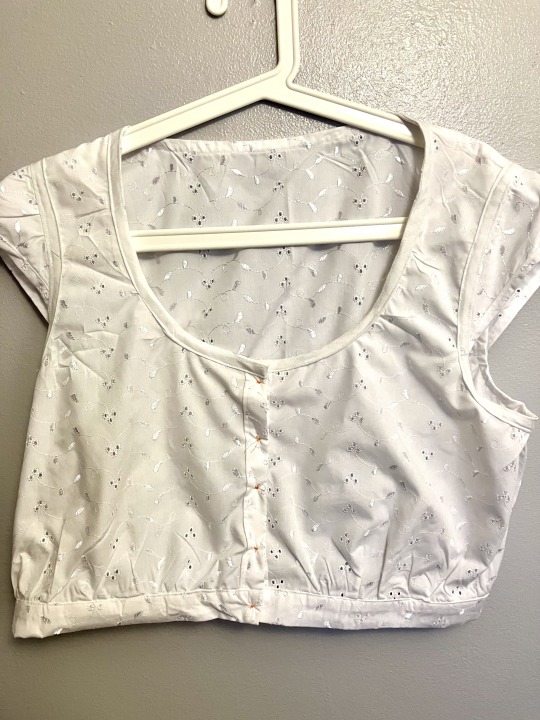
I've added pictures of the inside for this one. As you can see there are no raw edges anywhere in this blouse, which I LOVE. The seams are all french seams and the neckline/sleeve seam/armhole are all bound with an understitched bias facing. It makes the inside SO neat and tidy. So many patterns skimp on the seam finishing, instructing you to serge or overlock them (I don't have an overlocker nor any desire for one). And really if I wanted seams that were overlocked together, why would I bother making my own clothes. It's a seam finish I hate! I really appreciated the time put into the pattern to make the inside nice.
Next up is this fun orange number that I made as part of a Star Wars bounding outfit (I was BB-8). A lovely embroidered lawn which was SO lovely and well-behaved to work with. I cut it on the cross-grain so I could have the embroidery and cut work running parallel to the button bands


And lastly, this one in silk. It was a NIGHTMARE to work with. It's whisper-thin and slippery and semi-sheer. I gave it gelatine bath which did help to somewhat stabilise the fabric as I cut and sewed it but it also made it super staticky. I think I should have used more gelatine because although it was slightly papery it was still slippery and seemed to stretch and deform if you so much as looked at it wrong.
(Wait, I can hear you say. Gelatine? Like the stuff sweets are made of? Yes! It's a way of stabilising very find or floppy fabric. You mix gelatine and hot water (I used a ratio of 1 tsp to 500ml water), soak you fabric, and let it dry, whereupon you iron it, and cut out your pattern. It washes right out of the fabric when you are done).
The fabric fought me every step of the way. I was nearly done when I slipped cutting a buttonhole and ripped a tear in the button band. I had to do a small patch job and you can TOTALLY see it but I'm hoping the pattern makes it less obvious.
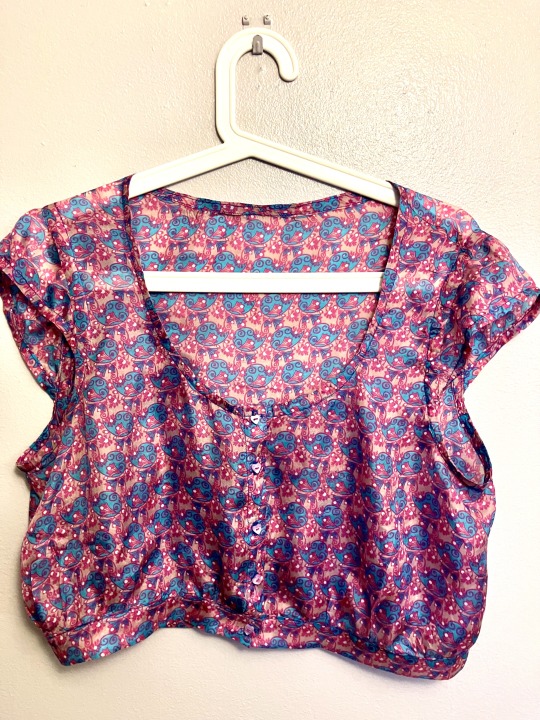

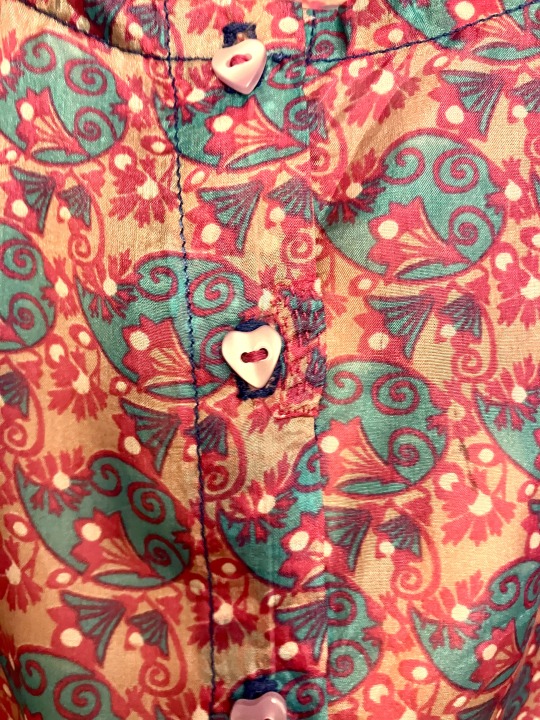
The finished blouse is wonderful to wear though, so light and elegant so I think it is worth it.
12 notes
·
View notes
Text
Lovers Rock
Alex spoke one (1) word in German in Vaincre? Well, he gets public sex in a club toilet in Berlin.
This is my gift for @noopienoopiernoopiest for the Noot Christmas Exchange. Hope you enjoy! And happy holidays everyone! read it on ao3 here.
(Raiting: E. Contains sex and mentions of alcohol)
As many of Alexander’s plans, Kasey didn’t know what, where, when or how it started.
But Alex had won their annual “vacation pick” game, and could choose their summer destination.
In his perennial state of confusion, Kasey thought of how two months prior Natalie and him had lost at Just Dance, and now there they were. In a cab in the centre of Berlin.
Natalie was looking out of the window, eyes glittering with the mesmerizing lights of the city. She was dressed in a web of straps, black leather and chains, that hugged her body in all the right places—getting out of their suite had taken longer than expected. The dark makeup and combat boots matched the city’s nightlife, just like the city matched Natalie’s core.
A hand moved on her leg.
Alexander was a show to behold himself.
Kasey, then again, didn’t know how, but one hour after an intercontinental flight and their arrive at the hotel, Alex already “had a guy” to buy clothes fit for the Berlin scene. And there he was, in an open, oversized blazer that left his chest bare and glinting with his necklace. Kasey had seen him double look the skirts many men wore around town, a bit wary—both Kasey and Nat had held their breaths—but in the end Alex had opted for large trousers. The beard uncut, the hair styled by Natalie—he was made to be devoured.
The redhead was sitting in between them, a hand on each partner. One on Natalie’s thigh, and one around Kasey’s shoulders. They had ordered a few drinks at the hotel and the air felt frizzy already, and all Kasey could think of was how all this turned them all on. Alex organizing a night out, taking pleasure in buying them things and taking them places. Treating and touching them, casually until they were alone, and then in a vertigo of sensations. He was always so careful, wonderful Alexander, to make them feel good. In body and mind. Even the boldest of smiles hid attentive eyes and drums in his chest.
The cab came to a stop, and Alex shouted an excited Danke, danke schön! and paid. Kasey fixed his crop top as they got out of the car, immediately surrounded by people lining at the entry of the first club. A hand immediately found his waist, and another his arm, and he felt theirs in the middle of the sidewalk.
Alex guided them to the VIP entry, showing something on his phone to the bodyguard, who nodded. A moment later, Natalie was dragging them inside in an excited run that Alex matched immediately. Kasey had accepted being dragged around by them as his philosophy of life, and didn’t have enough hands to adjust his pants as this all turned him on even more.
.
The club had been Natalie’s pick, and Kasey could see she felt in her element. Walls and ceilings were dark mirrors, that reflected purple neon lights at the beat of techno music. People moved freely around the small space, eyes closed and bare smiles. Either everyone knows everyone, or these people just like to dance against strangers, Kasey thought as he found himself in the middle of the room, feeling out of place—it was nothing like American clubs. Alex immediately went to get them drinks, with a kiss to their cheeks, and Natalie danced. Her arms, legs, head, every part of her body was in tune with music, space and people. Hypnotizing since day one, and fully aware of it, Natalie looked at Kasey in the eyes. Small hands took his, and evenings spent dancing in the kitchen came back in well-practiced steps. He finally felt himself relax into Natalie, and her smile as she noticed was blinding.
Alex came back with their drinks and the story of the bartender’s life, the club too loud to hear it anyways. The summer heat made the cocktails disappear quickly, and Kasey was glad, because Alex now had both hands free to grab Natalie’s waist as they danced. And, hell, did they dance. They found their rhythm, and each other’s lips, with an ease Kasey worshipped.
The move in Alex’s hips against Natalie’s, unapologetic to a fault, left him stare at them until, once again, he was pulled into their magic. Chest against chest against back, Kasey danced and remembered how they enjoyed being this close, in a room by themselves, and no clothes or techno involved.
But was it that different?
Alexander’s exposed Adam’s apple, Natalie going down before slowly coming up again. Hands that said mine, kisses that tasted of each other. Kasey pressed in between them, the scruff of Alex’s beard on his neck and Natalie’s hands on his chest, it all threw him back to other nights and other thoughts. He was sure Natalie could feel his semi-hard on just like he could feel Alex’s.
At any other time, Kasey would have done a double take. But it was summer, and they were free and together and without a care in the world for another three weeks. He was “pleasantly tipsy”, as Natalie liked to say, and they were in a club in Berlin. So, he let himself go, and feel, and touch, and dance with his two.
Two men who’d been dancing nearby for a while approached them, bending to ask Natalie something in German. When she shook her head, they tried with English. “Join us? Attractive people, all three!”
The smiles were polite, the eyes longing.
Natalie smiled back, caressing Alex’s hand, now on her waist. “No, thanks! Exclusive, ja? Mine.”
The duo nodded back enthusiastically and went back to their place after waving hands.
Before Natalie could turn to look at her men, Alex was kissing her neck while keeping Kasey close. “Yours, ja?”
Before Kasey knew, he was attacking the free side of Natalie’s neck, and Alex’s hands was in his jeans’ rear pocket.
“Fucking mine,” Natalie breathed, head tilted to give them more working room.
“Then let’s to the toilet.”
Once again, Kasey was being dragged by two hands through the chaos of the club. He saw men kissing men, women kissing women, and people kissing people in a whirlwind of lights. His heart was beathing everywhere with the loud music, but pulsing in one place specifically.
Urgency and desire were mixing too quickly to keep their hands to themselves. The rush to a free, secluded stall was inebriating, and before Alex could lock the door behind them, a mouth was on his neck and hands found his erection. Kasey kept a hand on the redhead’s mouth, and as expected, it vibrated with a moan. Alex pushed against the two hands working him through the fabric, needy and ready.
Natalie was hastily tying her hair when Alex shook his head.
“No time. Please.”
Kasey cursed under his breath as he let Natalie lower his trousers and boxers, focusing on a nipple for a second. The hot skin and the open access the jacket left made it too easy, and Alex was furrowing his brows more and more—they all knew what it meant.
Unable to stay still, Alex lowered his hand on Natalie, who nodded to the brush of fingertips against her. Kasey grinded into Alex’s ass, now set of what he wanted but not sure if he would last enough. Alex’s next moan against Kasey’s palm was a desperate prayer and warning, the urgency shaking his hips as Natalie worked on his length. Kasey could see her, too, relax and tense against Alex’s hand, biting her lip not to let a sound out.
Pushes and grinds against Kasey’s cock sent him too close to the edge multiple times, especially with Alex’s suffocated, wet moans against him. Kasey returned the hand on the nipple to Alex’s balls, touching them just like he knew would catapult him into ecstasy.
Sure as dawn, Alex stilled a moment later in a strangled groan, before relaxing against Kasey. Two heartbeats later, he was kneeling in front of Natalie.
It was her turn to be hushed by Kasey, with kisses this time. Alex worked her fast, moaning in appreciation at the hand pulling his hair.
“Yes, Alexander, fucking mine,” Natalie breathed.
When the redhead brought two fingers to her mouth, which were sucked desperately and thoroughly, before bringing them down again and looking at Kasey, the goalie felt them violently his.
A trembling hand reached for the condom in his wallet, unable to look away from where Alex was eating Natalie out greedily, eyes closed from his own fingers prepping himself. Natalie, too lost in her own pleasure to care, held her breath as her hips shook uncontrollably. Alex didn’t let go, insisting against the spasm until everything stilled.
Kasey helped Natalie on the toilet, kissing her gently and everywhere.
“Kase,” Alex called, breathless.
If he hadn’t been hard for an hour at that point, Kasey would have cradled Natalie as she recovered. He would have prepped Alex without haste, taking sweet time and slow moves. But he’d been horny all night, and Alex was waiting for him.
With a kiss to Natalie’s temple, he lined up behind Alex, making sure he was ready. He let their breaths sync before bringing a hand to Alex’s belly to keep them stable and close. From the corner of his eye, he could see Natalie cupping and stroking herself lazily as she stared at their almost connected bodies.
“Kase,” Alex urged again.
Kasey knew he wasn’t going to last the second his tip entered Alex. The breath was punched out of both of them, Alex leaning on the wall in front of him with his elbows, head rocking in between raised shoulders. Natalie’s litany of mine, both fucking mine, echoed in whispers in the stall.
“Oh, fuck, oh fuck, fuck,” Kasey muttered, squeezing his eyes shut as he was finally all in. He had to take a few deep breaths, focusing on Alex’s hot body bend before him. He ran a hand down his back.
“Alex, babe, relax,” he whispered. “It’s me, relax for me.”
It took Alex a while, a few of Natalie’s honey-sweet murmurs and praises, and deep breaths himself. When his hips sank more, and his shoulders lowered, Kasey called him Good boy, and began moving.
The best kind of heat was surrounding him. Natalie knelt to whisper to Alex and touch him, keeping him silent when Kasey hit the right spot too many times. Hands on the redhead’s hips, Kasey delivered short, quick thrusts, feeling tears at the corner of his eyes. Oh, it had been a long time since they’d done this. Before the league, before the distance, long enough to disturb an ache deep inside him. But they were together, in every sense, and feeling good.
Too good.
Kasey felt the tremors arrive at his feet, and that's when he knew the edge was just around the corner.
He tried to warn Alex, but before he could, Alex began meeting his thrusts, and that’s when Kasey saw nothing, and nothing was white.
.
They were walking hand in hand (in hand) by the canal. An early tram passed by, reflected in the orange and pink water of the sky at dawn. The city was slow to wake up, and silence made their heads pulse with the loudness of the night. They’d jumped from club to club, until morning had come. Baked goods from an early bakery had tasted like heaven, and water fountains had cooled them down. Tired smiles walked around in intertwined arms, and sat down on the steps before the canal.
“So.” Alex clapped his hands on his legs. “Where are we going tonight?”
.
16 notes
·
View notes